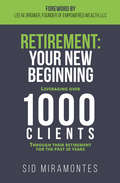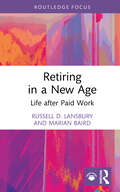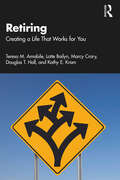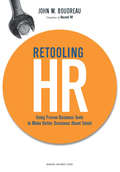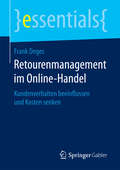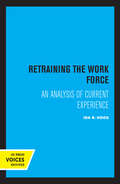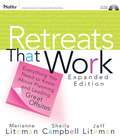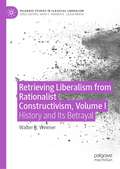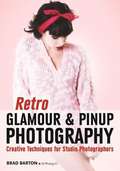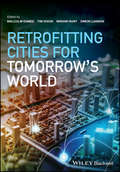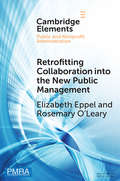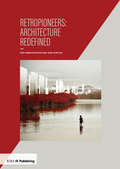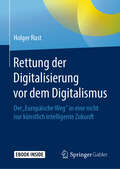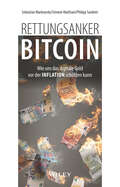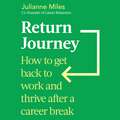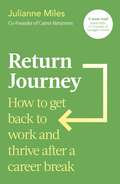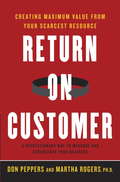- Table View
- List View
Retirement: Leveraging Over 1,000 Clients Through Their Retirement for the Past 20 Years
by Sid MiramontesA financial advisor shares stories from his practice and useful information on making retirement a smooth transition—and a rewarding experience. Helping someone plan for retirement is a very personal process. Having retired over a thousand individuals, Sid Miramontes has learned quite a few things along the way. Some situations are similar for each person. But others are unique to each individual—the personal, the exceptional, the human side of retirement. Retirement: Your New Beginning provides education on commonly confused retirement concepts and covers topics from taxes to Social Security to mutual funds, helping simplify the process with client stories that help the reader visualize their own retirement along with valuable tips on the dos and don&’ts.
Retiring Wealthy
by Gordon Pape"If you make a commitment and put together a carefully structured plan, you can indeed be among the few Canadians who will retire genuinely wealthy.<P> Make no mistake. It will require time, effort and, maybe, some sacrifice.<P> But then, what in life that's worthwhile does not?<P> Any time you feel your resolve weakening, think about the ultimate reward. Twenty, thirty, maybe even more years of living the way you want, free and independent. A home by the sea, a trip around the world, time with your family, a second career - all are possible and achievable.<P> It's in your hands now!"
Retiring in a New Age: Life after Paid Work (Routledge Focus on Business and Management)
by Marian Baird Russell D. LansburyThis book examines the concept of retirement, how it has changed, and what the future holds for the next generation of retirees.The book analyses government data and university surveys of more than 1,000 retirees in Australia and 4,000 retirees in Sweden, as well as in-depth interviews with retirees in each country. It demonstrates that while both countries have differences in their retirement policies and practices, as well as the outcomes for retirees, the process of retirement is undergoing change in both countries as people retire at a range of ages, but often then re-enter the workforce for various reasons. The book proposes four distinctive post-retirement orientations: Stayers, Leavers, Blenders and Disengaged retirees. It then discusses how individuals, employers and governments are responding to the challenges of ‘retiring in a new age’, suggesting policies and a new social contract for retirees that addresses their needs for economic security, physical and mental health, as well as engagement with the wider community.A book of keen interest to scholars of employment and work relations, human resource management, as well as labour economics. Policymakers and students interested in employment issues that affect economic and social equality will also find the book’s framework fit for use. A full set of interview transcripts and discussion questions is available on the Routledge webpage for download: www.routledge.com/9781041118329
Retiring: Creating a Life That Works for You
by Kathy E. Kram Douglas T. Hall Teresa M. Amabile Lotte Bailyn Marcy CraryRetirement, as a major life transition, can be both thrilling and challenging in unexpected ways. Written by acclaimed authors in the fields of business leadership, careers, and work, this book goes beyond the typical financial and health-related advice on retirement, providing insights to guide you in broader areas of your life – identity issues, relationship challenges, and questions about creating a new retirement life structure that works for you. With lively, engaging writing, the book tells the detailed retirement transition stories of 14 people – and draws on over 200 interviews with 120 people – to explore how retiring involves a reconstruction of both the person and their life structure. You’ll gain wisdom on the common themes and the wildly different approaches people take to the four big tasks of retiring: making the retirement decision, detaching from work both tangibly and psychologically, building a new life structure for retirement, and settling into a relatively stable retirement life – but prepared to restructure again as life unfolds into the future. Throughout each chapter, you’ll see how the dynamic interplay of self, life structure, and external context affect a retiring person’s day-to-day experience in the final months of their career, as well as their early years of retirement – and how life satisfaction depends largely on alignment among the three. At the same time, you’ll learn how family, friends, and colleagues, as well as the organization the person is retiring from, can play a crucial role.This book is for you if you are seeking deep, nuanced insight into – and practical advice on – the psychological, social, and life-restructuring aspects of retirement that can make all the difference for life satisfaction. It is also for you if you are a family member or friend of a retiring person, a helping professional, or an organizational leader who cares about your older workers and the value they bring to your organization even as they depart.
Reto S.A.
by William J. Bruns Jr.A company must decide whether to acquire new equipment to offer a new product line. The question is whether equipment will meet return on investment targets considering depreciation and taxation of profits. The equipment is acquired, but one year later better equipment becomes available. A rewritten version of an earlier case.
Retooling HR
by John W. BoudreauHR professionals have made major strides toward becoming strategic partners. But they need to do more - by generating value through savvy decisions about talent. HR leaders typically assume that, to make such decisions, they must develop sophisticated analytical tools from scratch. Even then, the resulting tools often fail to engage their peers.In Retooling HR, John Boudreau shows how HR leaders can break this cycle - by adapting powerful analytical tools already used by other functions to the unique challenges of talent management.Drawing on his research and examples from companies including Google, Disney, IBM, and Microsoft, Boudreau explains six proven business tools leaders already use. And he shows how HR can apply these tools to talent management. Examples include:· Using engineering tolerances to find pivot points that job descriptions miss· Using inventory and supply-chain analytics to ensure a ready supply of the right talent· Applying logistics tools to optimize succession planning and leadership development· Adapting consumer research tools to find untapped value in total rewardsRetooling HR builds on Boudreau's bestselling book Beyond HR, which traces HR's evolution as a decision science. For HR professionals seeking to sharpen their decision-making prowess, this provocative new book blazes an innovative new path.
Retourenmanagement im Online-Handel: Kundenverhalten beeinflussen und Kosten senken (essentials)
by Frank DegesDas essential vermittelt die Grundlagen des Retourenmanagements im Internet-Handel. Frank Deges erl#65533;utert eine Vielzahl von Handlungsoptionen, mit denen Online-H#65533;ndler durch pr#65533;ventive und reaktive Ma#65533;nahmen das Kundenverhalten beeinflussen, das Retourenaufkommen minimieren und die Retourenkosten senken k#65533;nnen. Online-H#65533;ndler d#65533;rfen Retouren nicht als gegeben hinnehmen, denn eine hohe Retourenquote belastet die Marge und kann insbesondere kleine Onlineshops schnell in eine existenzgef#65533;hrdende Lage bringen. Erg#65533;nzend wird aufgezeigt, wie sich der Erfolg einer unternehmensspezifischen Retourenstrategie durch Kennzahlen im Rahmen eines Retourencontrollings messen l#65533;sst.
Retraining the Work Force: An Analysis of Current Experience
by Ida R. HoosThis title is part of UC Press's Voices Revived program, which commemorates University of California Press’s mission to seek out and cultivate the brightest minds and give them voice, reach, and impact. Drawing on a backlist dating to 1893, Voices Revived makes high-quality, peer-reviewed scholarship accessible once again using print-on-demand technology. This title was originally published in 1967.
Retreats That Work
by Sheila Campbell Jeffrey Liteman Merianne LitemanBased on the best-selling first edition, this greatly expanded and updated version contains forty-seven new activities, more information about how to design and lead retreats, and additional suggestions for how to recover when things go wrong. A CD-ROM allows you to print out chapters for distribution to key leaders, duplicate templates, and produce handouts for specific exercises.Whether you're planning to lead an offsite retreat for the first time or the ninety-ninth time, this easy-to-use, one-stop resource provides: Step-by-step instructions for leading a wide variety of tested exercises. Insight into establishing effective working relationships with clients. Information on what to include in your retreat designs. Suggestions for encouraging participants to speak up and play an active role. Tools for managing conflict. Guidance on making decisions during a retreat and changing course when necessary. Strategies for developing and implementing action plans. Tips for follow-up so you can keep the change train on track.Order your copy of this practical guide today!
Retrieving Liberalism from Rationalist Constructivism, Volume I: History and Its Betrayal (Palgrave Studies in Classical Liberalism)
by Walter B. WeimerThis first volume, History and its Betrayal, traces the development of major themes of liberalism from the increase in human population beyond the limits of the face-to-face society of tribalism and small groups up until the present day. It shows that the principles underlying liberalism are the evolutionary development of social organizations that have resulted from the complexity of human action rather than any conscious design or purpose.This book draws out the differences between the classical liberalism dependent upon spontaneous and tacit ordering as a result of evolution, and the explicit or conscious or directed version of progressivism. It shows that the most important recent developments in the philosophy of rationality and the methodology of scientific research, as well as in evolutionary epistemology and the philosophy of biology, actually stem from the theories of complex social organization of the moralists such as Hume, Ferguson, and Smith. The book shows clearly that classical liberalism was never refuted—indeed, no attempt to do so has been offered—it has simply been ignored in favour of programs which sound beneficial and soothing but which cannot be instituted without returning to tribalism.
Retrieving Liberalism from Rationalist Constructivism, Volume II: Basics of a Liberal Psychological, Social and Moral Order (Palgrave Studies in Classical Liberalism)
by Walter B. WeimerThis second volume, Basics of a Liberal Psychological, Social and Moral Order, overviews developments in the theory of spontaneously ordered complex phenomena, the psychology of inference and expectation, the nature of anticipatory systems in the psychological and economic domains, and the evolution of scientific thought and knowledge. The book applies these insights to the nature of markets and morals, what education should consist of, and the problems of alienation and our existential malaise as we move into an increasingly abstract society. In doing so it also shows the unscientific nature of the rationalist constructivist approach of progressivism, and the disastrous consequences that would arise from following these positions. The book shows the complex interplay between top-down or directed structures (what Hayek and others have called taxis organizations) and far more complex orders of the social or psychological cosmos in which they are embedded as constituents. It details how the key to the market orders of society depends upon their capacity to impersonally convey information to agents. Markets can serve unknown and unforeseen ends for individuals who do not know or have contact with other market participants. This is a vastly more powerful and productive system than anything that can arise in a tribal or face-to-face organization limited to personal contact, such as the sort proposed by the constructivists. The book will be of interest to academics and scholars in classical liberalism, economics and political philosophy.
Retro Glamour and Pinup Photography
by Brad BartonToday’s portrait photographers owe a debt of gratitude to old-school pin-up and glamour photographers, who knew how to entice viewers with images that ooze with a playful, come-hither sexuality. The subjects were impeccably posed, lit, attired, and directed to ensure that every portrait was evocative and gave viewers insight into the woman’s personality -- whether she were a smokey-eyed siren or a girl-next-door type. In this book, award-winning photographer Brad Barton (Fort-Worth, TX) compiles 60 memorable final portraits, behind-the-scenes shots, and image alternates that show a range of styles that duplicate (and re-invent) vintage looks his clients and portrait recipients love. Readers will learn how to connect with clients, create effective lighting setups, correct perceived flaws through posing, drum up playful prop-and-set combinations to develop a portrait theme, and more. Readers will also find a host great tips for maximizing each image through thoughtful and efficient post-production work. Armed with the tips in this book, beginners and pros alike will find a renewed creative vision and have at hand the powerful tools required to bring their portrait ideas to life.
Retro Glamour and Pinup Photography
by Brad BartonToday’s portrait photographers owe a debt of gratitude to old-school pin-up and glamour photographers, who knew how to entice viewers with images that ooze with a playful, come-hither sexuality. The subjects were impeccably posed, lit, attired, and directed to ensure that every portrait was evocative and gave viewers insight into the woman’s personality -- whether she were a smokey-eyed siren or a girl-next-door type. In this book, award-winning photographer Brad Barton (Fort-Worth, TX) compiles 60 memorable final portraits, behind-the-scenes shots, and image alternates that show a range of styles that duplicate (and re-invent) vintage looks his clients and portrait recipients love. Readers will learn how to connect with clients, create effective lighting setups, correct perceived flaws through posing, drum up playful prop-and-set combinations to develop a portrait theme, and more. Readers will also find a host great tips for maximizing each image through thoughtful and efficient post-production work. Armed with the tips in this book, beginners and pros alike will find a renewed creative vision and have at hand the powerful tools required to bring their portrait ideas to life.
Retrofitting Cities for Tomorrow's World
by Tim Dixon Malcolm Eames Miriam Hunt Simon LannonA groundbreaking exploration of the most promising new ideas for creating the sustainable cities of tomorrow The culmination of a four-year collaborative research project undertaken by leading UK universities, in partnership with city authorities, prominent architecture firms, and major international consultants, Retrofitting Cities for Tomorrow's World explores the theoretical and practical aspects of the transition towards sustainability in the built environment that will occur in the years ahead. The emphasis throughout is on emerging systems innovations and bold new ways of imagining and re-imagining urban retrofitting, set within the context of 'futures-based' thinking. The concept of urban retrofitting has gained prominence within both the research and policy arenas in recent years. While cities are often viewed as a source of environmental stress and resource depletion they are also hubs of learning and innovation offering enormous potential for scaling up technological responses. But city-level action will require a major shift in thinking and a scaling up of positive responses to climate change and the associated threats of environmental and social degradation. Clearly the time has come for a more coordinated, planned, and strategic approach that will allow cities to transition to a sustainable future. This book summarizes many of the best new ideas currently in play on how to achieve those goals. Reviews the most promising ideas for how to approach planning and coordinating a more sustainable urban future by 2050 through retrofitting existing structures Explores how cities need to govern for urban retrofit and how future urban transitions and pathways can be managed, modeled and navigated Offers inter-disciplinary insights from international contributors from both the academic and professional spheres Develops a rigorous conceptual framework for analyzing existing challenges and fostering innovative ways of addressing those challenges Retrofitting Cities for Tomorrow's World is must-reading for academic researchers, including postgraduates insustainability, urban planning, environmental studies, economics, among other fields. It is also an important source of fresh ideas and inspiration for town planners, developers, policy advisors, and consultants working within the field of sustainability, energy, and the urban environment.
Retrofitting Collaboration into the New Public Management: Evidence from New Zealand (Elements in Public and Nonprofit Administration)
by Rosemary O'Leary Elizabeth EppelThis Element is about the challenges of working collaboratively in and with governments in countries with a strong New Public Management (NPM) influence. As the evidence from New Zealand analyzed in this study demonstrates, collaboration – working across organization boundaries and with the public – was not inherently a part of the NPM and was often discouraged or ignored. When the need for collaborative public management approaches became obvious, efforts centered around “retrofitting” collaboration into the NPM, with mixed results. This Element analyzes the impediments and catalysts to collaboration in strong NPM governments and concludes that significant modification of the standard NPM operational model is needed including: Alternative institutions for funding, design, delivery, monitoring and accountability; New performance indicators; Incentives and rewards for collaboration; Training public servants in collaboration; Collaboration champions, guardians, complexity translators, and stewards; and paradoxically, NPM governance processes designed to make collaborative decisions stick.
Retrofitting the Built Environment
by William Swan Philip BrownThe physical upgrading of the existing domestic and industrial building stock to improve energy performance is an essential part of a transition to a low carbon society. Successfully retrofitting buildings to improve energy performance is not simply a technological challenge, it is a complex socio-technical problem that needs to be addressed in a co-ordinated way, utilising skills and knowledge from a range of industrial and academic backgrounds. Within both the academic and practitioner communities there is a growing understanding of the scale and nature of the problem, one which encompasses issues such as policy and regulation, people and behaviour, supply chain and process, as well as issues of technology. Retrofitting the Built Environment discusses the factors that impact on the retrofit problem, providing a clear analysis of the main issues that the academic and industrial communities must engage with to resolve the problems of domestic energy and retrofit. The book is divided into four broad sections: Understanding the Problem Policy and Regulation Implementing and Evaluating Retrofit People and Communities Academic and industrial researchers, policy makers and industry practitioners will find each section covers a mix of policy, technical and social science issues, presented by both academic and industry authors, giving a wide and detailed perspective of the issue. The Editors Will Swan is a Senior Lecturer in Buildings Retrofit in the School of the Built Environment at the University of Salford. He leads a number of projects in the field of sustainable retrofit, covering a number of topics including monitoring, behaviour and retrofit project delivery, as part of Salford’s Applied Energy and Buildings Research Group. He sits on the Greater Manchester Buildings Group and also is Chair of the Retrofit Innovation Group. Philip Brown is Director and Senior Research Fellow at the Salford Housing & Urban Studies Unit (SHUSU) at the University of Salford. He is the lead academic on end-use energy demand within the Applied Energy and Buildings Research Group, and sits on Greater Manchester’s Low Carbon Economic Area group for Customer Engagement.
Retropioneers: Architecture Redefined
by Jane DuncanWhat does the future of the construction industry look like? This book brings together opinion pieces by all RIBA Ambassadors and other leading construction voices, setting the scene for how our industry will look in the future and the role that architects could, and perhaps should, play in this new world.
Retrospectives on Public Finance
by Lorraine EdenRetrospectives on Public Finance contains original analyses by internationally recognized public finance scholars, including Carl Sumner Shoup, one of the discipline's most famous practitioners. Shoup, along with Richard Musgrave and his students, pioneered the "prescriptive" or "political economy school" of public finance known for its hands-on approach and its commitment to applying theory to real world problems.Each contributor provides a retrospective on Shoup's various contributions to the field, reviewing the literature and assessing its relevance to current problems in public finance theory and policy. The essays highlight and analyze fiscal theory and public policy developments from the 1930s to the present in four areas: the Shoup tax missions to Japan, Venezuela, and Liberia; the tax mix; the expenditure mix; and macro public finance.Contributors. Lorraine Eden, Carl S. Shoup, Malcolm Gillis, Minoru Nakazato, Charles E. McLure Jr., John Bossons, Richard Goode, William Vickery, Wayne Thirsk, John Graham, Stanley Winer, W. Irwin Gillespie, Melville L. McMillan, Cliff Walsh, John G. Head, Enid Slack, Edwin G. West, Richard M. Bird, Peggy B. Musgrave, Douglas A. L. Auld, John B. Burbidge, Jack M. Mintz, John Sargent, Richard A. Musgrave
Rettung der Digitalisierung vor dem Digitalismus: Der "Europäische Weg" in eine nicht nur künstlich intelligente Zukunft
by Holger RustDigitalisierung ist längst kein Zukunftsprojekt mehr, sondern zukunftsbestimmende Gegenwart. Auf die Arbeits- und Lebenswelt, die heute entsteht, müssen sich Nachwuchskräfte einstellen, die mit den Folgen von Entscheidungen konfrontiert sein werden, an denen sie selbst kaum beteiligt sind. Welche Optionen gibt es, eine eigene Zukunft zu gestalten? Das Buch bietet Antworten auf der Grundlage von Befunden eines großen Forschungsprojekts, in dem sich unter Leitung des Autors 73 junge Nachwuchskräfte und Digital Natives mit ausgeklügelten Methoden dieser Frage gestellt haben. Das Ergebnis: Gefordert ist eine kreative Digitalisierung, die in den Bedürfnissen des Alltags verankert ist, andere innovative Impulse setzt als die algorithmische Überfremdung der Wirklichkeit und so die Fantasielosigkeit eines technokratischen Digitalismus überwindet.
Rettungsanker Bitcoin: Wie uns das digitale Gold vor der Inflation schützen kann
by Philipp Sandner Sebastian Markowsky Simone MatthaeiImmer wieder lesen wir in den Medien von großen Bitcoin-Hacks, extremen Kursschwankungen oder von Kriminellen, die im Darknet mit Hilfe von Bitcoin ihr Unwesen treiben. So hat der Bitcoin ein Schmuddel-Image bekommen. Tatsächlich kann uns der Bitcoin aber helfen, der kommenden Inflation zu begegnen und andere Krisen in den Griff zu bekommen. Sebastian Markowsky und Philipp Sandner gehören zu den besten Bitcoin-Finanzexperten Deutschlands. Gemeinsam mit Simone Matthaei räumen sie in ihrem Buch mit den Vorurteilen gegenüber dem Bitcoin auf. Sie tun dies, weil sie überzeugt sind, dass der Bitcoin bei den existierenden und sich anbahnenden existentiellen Krisen der entscheidende Rettungsanker sein kann. Krisen, die da heißen: Steigende Inflation, die das Leben für viele Menschen unbezahlbar macht und lebenslange Ersparnisse vernichtet. Ein dramatischer Investitionsstau, der dazu führt, dass die notwendigen Investitionen in die Zukunft, im Energiesektor, beim Klimaschutz oder beim Aufbau einer weltweiten Kreislaufwirtschaft gar nicht oder viel zu zögerlich vorankommen. Die Autoren zeigen sowohl, sich der Einzelne vor der Inflation schützen kann als auch, wie durch die Einführung des Bitcoins als Zahlungsmittel diesen Krisen begegnet werden kann.
Return Journey: How to get back to work and thrive after a career break
by Julianne MilesA highly useful, inspiring guide for anyone returning to work after a career break, by a world-renowned return to work expert and Chartered Psychologist.'A must read for anyone who wants to return to work.' SARAH ELLIS, co-founder of Squiggly Careers'Accessible, informative and full of sound advice .' JANE GARVEY___________________________________________________Returning to work after a career break - for childcare, eldercare, for health or other reasons - can feel daunting and overwhelming. You don't have to find your way back alone.In Return Journey, Julianne Miles - a world-renowned return-to-work expert, Chartered Psychologist, and a successful returner herself - offers a psychology-led, step-by-step guide for any professional looking to get back to fulfilling work. Using a mix of practical advice, coaching exercises and real-life case studies, Return Journey will be your wise companion at every stage: from boosting your confidence as you start out, to offering advice on an effective job search strategy, to helping prepare you emotionally and practically for the first months back.Above all, Julianne proposes that returning to work is not about hiding your career break or struggling to catch up. It's about properly valuing your wealth of skills and experience, taking control of your story, and coming back stronger than ever before.
Return Journey: How to get back to work and thrive after a career break
by Julianne MilesA highly useful, inspiring guide for anyone returning to work after a career break, by a world-renowned return to work expert and Chartered Psychologist.'A must read for anyone who wants to return to work.' SARAH ELLIS, co-founder of Squiggly Careers'Accessible, informative and full of sound advice .' JANE GARVEY___________________________________________________Returning to work after a career break - for childcare, eldercare, for health or other reasons - can feel daunting and overwhelming. You don't have to find your way back alone.In Return Journey, Julianne Miles - a world-renowned return-to-work expert, Chartered Psychologist, and a successful returner herself - offers a psychology-led, step-by-step guide for any professional looking to get back to fulfilling work. Using a mix of practical advice, coaching exercises and real-life case studies, Return Journey will be your wise companion at every stage: from boosting your confidence as you start out, to offering advice on an effective job search strategy, to helping prepare you emotionally and practically for the first months back.Above all, Julianne proposes that returning to work is not about hiding your career break or struggling to catch up. It's about properly valuing your wealth of skills and experience, taking control of your story, and coming back stronger than ever before.
Return Logic, Inc, (A)
by Richard G. Hamermesh Michele LutzFollows three graduating HBS students as they build a business-to-business Internet venture and highlights the challenges they confront in structuring financing terms with venture capitalists. Requires students to carefully read a six-page term sheet to identify which provisions should and should not be accepted.
Return On Customer
by Don Peppers Martha RogersVirtually everyone agrees that a company's most important and scarcest asset is its customers. Yet the value of this vital asset is routinely ignored. This is the first book to focus on assessing and tracking customer equity - i. e. , the lifetime value of current and future customers - and taking specific actions to increase that equity. Bestselling business authors Peppers and Rogers reveal the critical importance of measuring customers' long-term profitability, productivity and loyalty. They then identify the specific products, add-ons and services that managers and executives can use to increase the size and value of their customer base. Based on a blend of theory and practice, Return on Customer offers a genuine new way to make customer retention and value part of a company's core competitive advantage.
Return On Process (ROP): Getting Real Performance Results from Process Improvement
by Michael WestAlthough there are countless books about process improvement and business performance, there is a dearth of literature on how process improvement yields business performance results. Filling this need, Return On Process (ROP): Getting Real Performance Results from Process Improvement provides strategic and tactical guidance on how to achieve a posi
